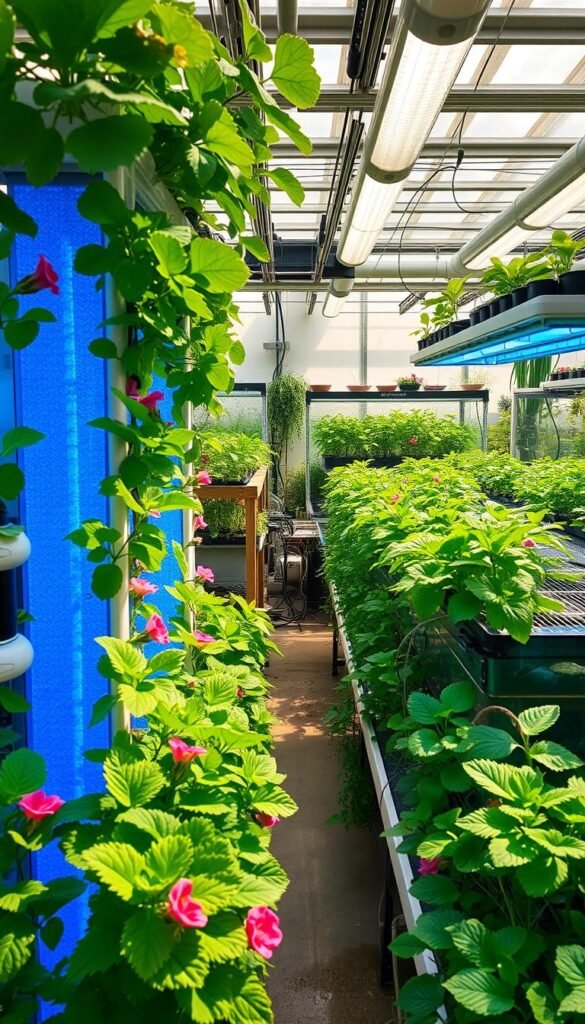Thinking about growing plants without soil? You’ve likely heard of aquaponics and hydroponics. Both methods ditch traditional dirt farming, but they work in very different ways. Let’s break down how these systems operate—and what makes each unique.
In aquaponics, fish and plants grow together in a closed-loop ecosystem. Fish waste gets broken down by bacteria into nutrients that feed the plants. Meanwhile, hydroponics relies on synthetic nutrient solutions added directly to water. No fish, just carefully balanced mixes to fuel plant growth.
Which option fits your goals? We’ll compare setup costs, maintenance needs, and environmental impacts. You’ll learn how factors like water usage, oxygen levels, and nutrient cycling differ between the two. Real data on efficiency and resource use will help you decide.
Curious about system designs? Hydroponic setups often use methods like the nutrient film technique, where roots sit in shallow streams of solution. Aquaponic systems need space for fish tanks and biofilters. Both require monitoring pH and nutrient levels, but one adds fish care to your routine.
By the end, you’ll know whether a fish-powered ecosystem or a precision-controlled hydroponic setup aligns with your gardening style. Let’s dive in!
Overview of Aquaponic Gardening and Hydroponic Methods
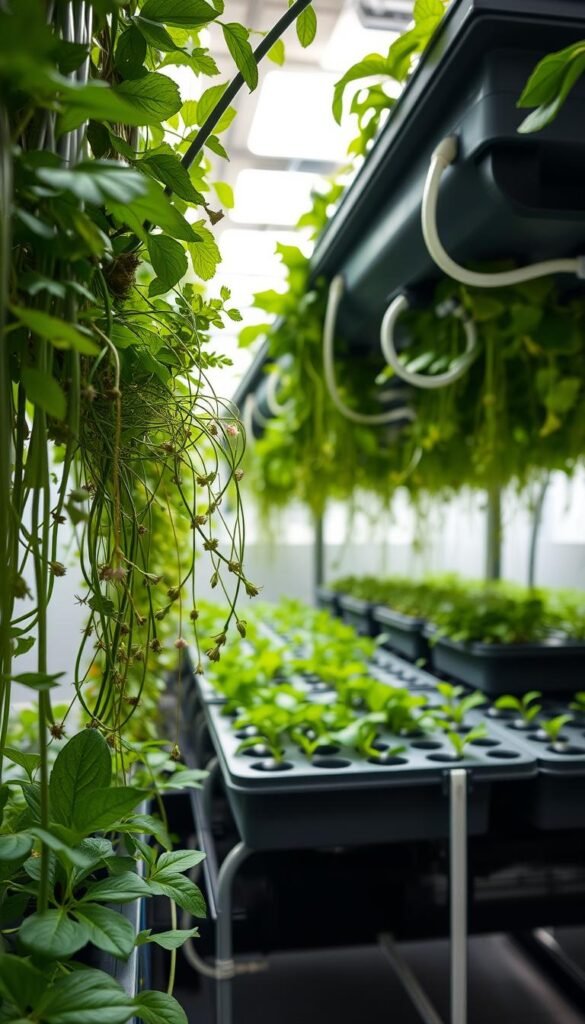
Soil-free agriculture is revolutionizing how we cultivate plants. These soilless growing techniques eliminate traditional limitations, letting you grow food faster while using fewer resources. Whether you’re a hobbyist or a sustainability advocate, understanding these methods helps you make informed choices.
Introducing Soilless Growing Techniques
Aquaponics and hydroponics are two pillars of modern soil-free farming. In aquaponics, fish tanks and grow beds work together. Fish waste feeds beneficial bacteria, which convert it into nitrates—a natural nutrient solution for plants. Hydroponics skips the fish, relying on premixed formulas added to water.
Both systems save up to 90% more water than soil farming. They’re perfect for urban spaces or areas with poor soil quality. Components like pumps, grow trays, and pH monitors keep everything running smoothly.
Why Compare Aquaponics and Hydroponics?
Choosing between these methods depends on your priorities. Aquaponics creates a mini-ecosystem, producing both fish and greens. It’s organic but requires balancing fish health and plant needs. Hydroponics offers precise control over nutrient levels, ideal for rapid hydroponic system maintenance and predictable yields.
Key factors to weigh:
- Environmental impact: Aquaponics recycles water endlessly
- Setup complexity: Hydroponics often has simpler initial costs
- Long-term sustainability: Fish add natural fertilizer but need care
Understanding the Aquaponic System
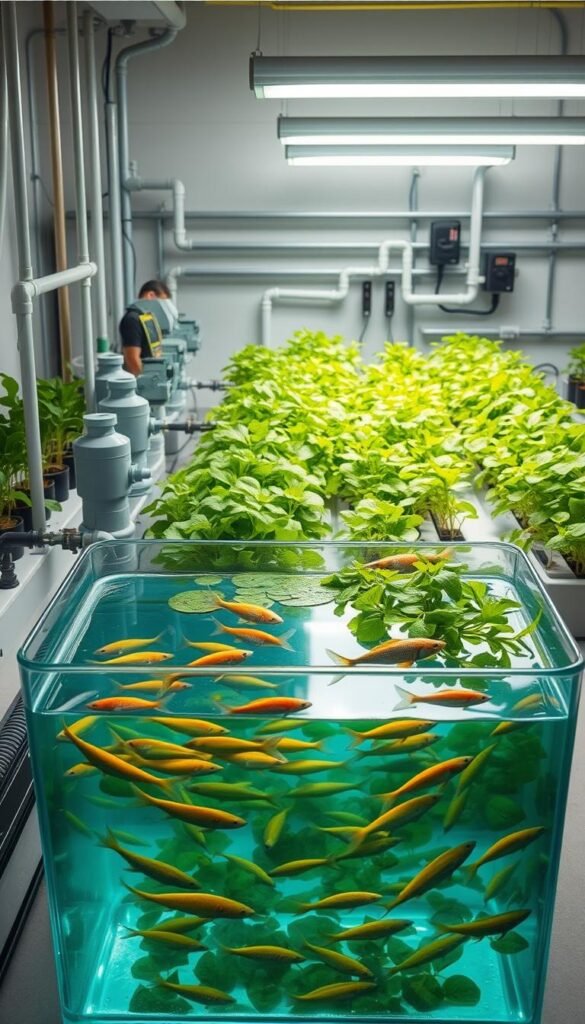
Imagine a garden where fish do half the work. Aquaponics creates a self-cleaning habitat that feeds plants while raising edible fish. This method turns waste into resources through natural processes.
Nature’s Recycling Program
Here’s how it works: fish release ammonia-rich waste. Beneficial bacteria break it into nitrates—a prime nutrient source for greens. Plants absorb these nutrients, filtering water that cycles back to the fish. No synthetic fertilizers needed.
Home setups often use:
- Tilapia or goldfish in compact tanks
- Grow beds filled with clay pellets or gravel
- Biofilters to house nitrifying bacteria
Why Gardeners Love This Approach
Aquaponics slashes water use by 90% compared to soil gardening. Since it’s a closed loop, you only top off evaporation losses. Home systems often yield veggies 2x faster due to constant nutrient access.
| Component | Role | Example |
|---|---|---|
| Fish Tank | Houses aquatic life | 100-gallon plastic tub |
| Grow Bed | Supports plant roots | Flood-and-drain tray |
| Biofilter | Hosts bacteria colonies | Moving bed reactor |
You’ll harvest both herbs and fish year-round. Lettuce thrives in 30 days instead of 60. Best part? Zero pesticides—fish health depends on chemical-free water.
Understanding Hydroponic Systems
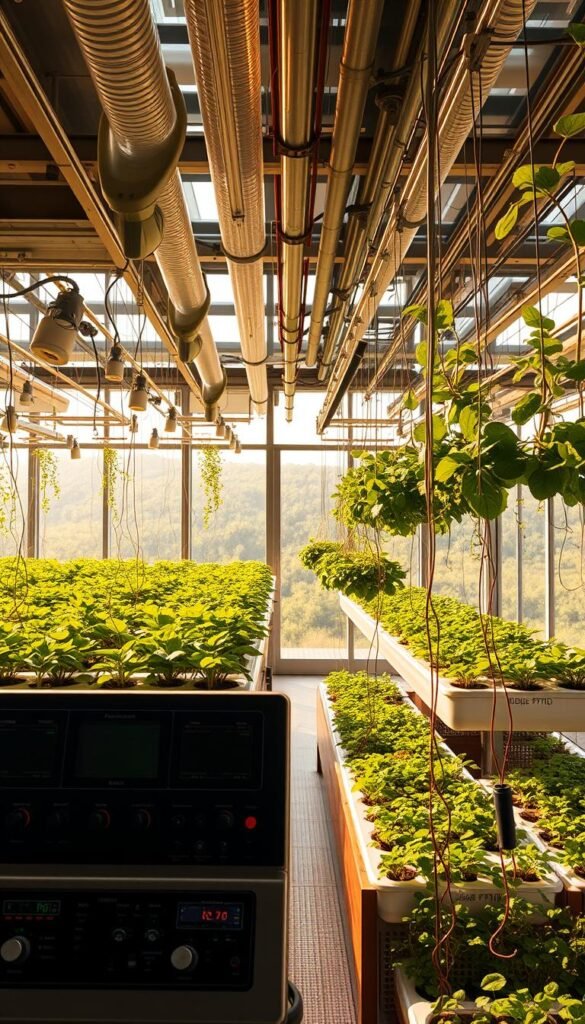
Ever wondered how plants thrive without a speck of dirt? Hydroponic systems deliver nutrients directly to roots through water, bypassing soil entirely. This precision-driven approach lets you control every bite your greens take.
Essential Features of Hydroponics
At its core, hydroponics uses a nutrient solution mixed with water. Plants anchor their roots in inert media like perlite or coconut coir. Oxygen pumps keep roots breathing, while pH monitors ensure optimal absorption.
No soil means no weeds or pests stealing resources. You decide exactly what—and how much—your plants consume. Studies show hydroponic lettuce grows 30% faster than soil-grown varieties.
Popular Hydroponic Techniques and Setups
Three methods dominate home and commercial setups:
- Nutrient Film Technique (NFT): Roots dangle in shallow streams of solution
- Deep Water Culture (DWC): Plants float on rafts above oxygen-rich water
- Drip Systems: Timed pumps deliver solution to individual plants
| Technique | Best For | Setup Complexity |
|---|---|---|
| NFT | Leafy greens | Moderate |
| DWC | Herbs | Simple |
| Drip | Tomatoes/Peppers | Advanced |
Urban growers love vertical NFT towers—they produce 20 plants per square foot. Commercial strawberry farms often use drip systems for precise feeding. Water use? Just 10% of traditional farming.
While synthetic nutrients are required, yields speak for themselves. Basil grown hydroponically develops 50% more essential oils than soil counterparts. Your kitchen could host a mini farm within weeks.
Comparing Nutrient Sources and Water Use
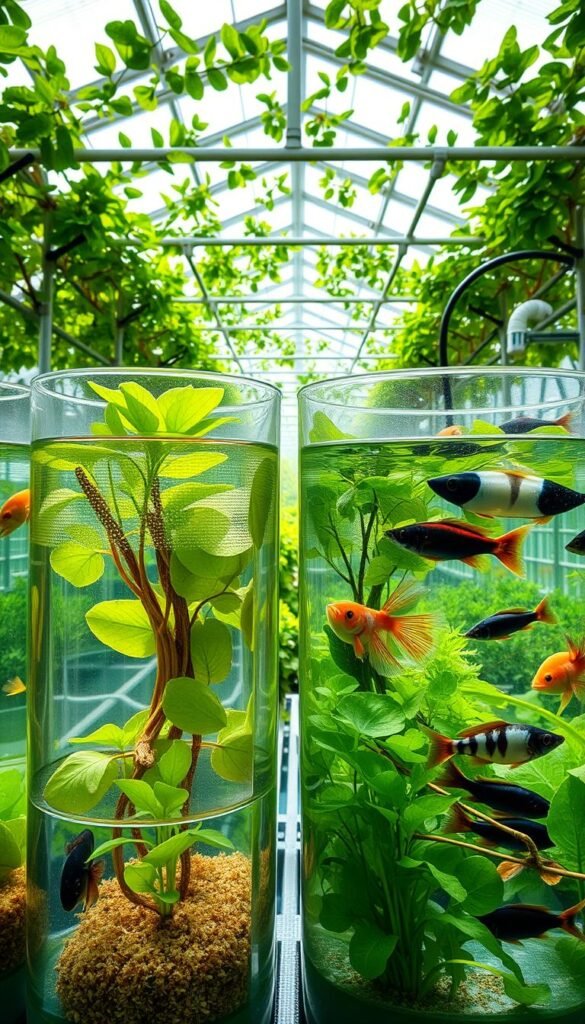
What fuels your plants’ growth makes all the difference. Aquaponics and hydroponic systems take opposing paths to nourish crops—one relies on nature’s leftovers, the other on lab-made formulas.
Organic Nutrients versus Synthetic Nutrients
In aquaponics, fish waste becomes a buffet for plants. Bacteria convert ammonia from fish into nitrates—a natural nutrient solution that greens absorb. This cycle mimics wetlands, where nothing goes to waste. You’ll never buy fertilizers, but you’ll feed fish daily.
Hydroponics skips biology class. Growers mix synthetic salts into water to create precise nutrient levels. Want more phosphorus for tomatoes? Adjust the recipe. Studies show these formulas boost yields by 25% compared to soil, but they lack the microbiome benefits of aquaponic systems.
Water Efficiency in Both Systems
Aquaponics wins the conservation race. Research shows it uses 90% less water than traditional farming—evaporation is the only loss. Water circles endlessly between fish tanks and grow beds. Hydroponics reuses its solution too, but pumps and leaks can waste up to 10% monthly.
| System | Water Added Weekly | Nutrient Source |
|---|---|---|
| Aquaponics | 2-3 gallons | Fish waste |
| Hydroponics | 5-7 gallons | Synthetic mix |
Both methods demand pH checks. Fish thrive at 6.8-7.0, while hydroponic lettuce prefers 5.5-6.5. Stray outside these ranges, and plants starve—even with perfect nutrients in the water.
Differences in System Design and Maintenance
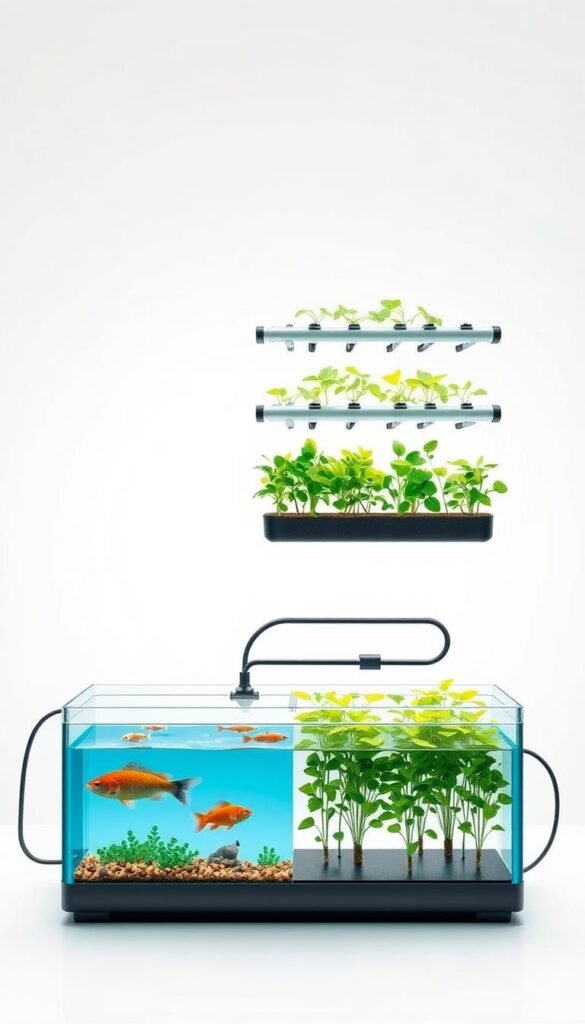
Building your first soilless garden? System design shapes everything—from startup bills to daily chores. Aquaponics and hydroponics demand distinct layouts and upkeep routines. Let’s explore what each method requires to stay productive.
Setup Costs and Complexity
Aquaponics needs more than just grow lights. You’ll need fish tanks, biofilters, and aeration pumps. These parts add $200-$500 to initial costs versus hydroponics. Fish prices vary—tilapia fingerlings cost $1-$3 each, while synthetic nutrients run $20/month.
Hydroponic setups shine in simplicity. A basic deep water culture kit fits on a countertop. No fish means fewer moving parts. Expect to spend 30% less upfront compared to aquaponic systems.
| Component | Aquaponics Cost | Hydroponics Cost |
|---|---|---|
| Grow Bed | $80-$150 | $50-$100 |
| Water Pump | $60 | $40 |
| Biofilter | $120 | N/A |
Maintenance Challenges You May Face
Fish turn aquaponics into a live-in science project. Test water pH daily—7.0 keeps both plants and fish happy. Clogged biofilters? Rinse them weekly to prevent ammonia spikes. Power outages risk killing your entire ecosystem in hours.
Hydroponics has its own headaches. Roots drown without proper oxygen flow. Check nutrient levels every 3 days—imbalances stunt growth fast. Leaky pipes? They waste 10% of your solution monthly if unchecked.
Both systems need vigilance, but aquaponics adds biological variables. Forget feeding fish for two days? Your nutrient supply crashes. Hydroponic growers skip this stress but miss out on natural fertilizer benefits.
The Pros and Cons of Aquaponic Gardening vs. Hydroponic
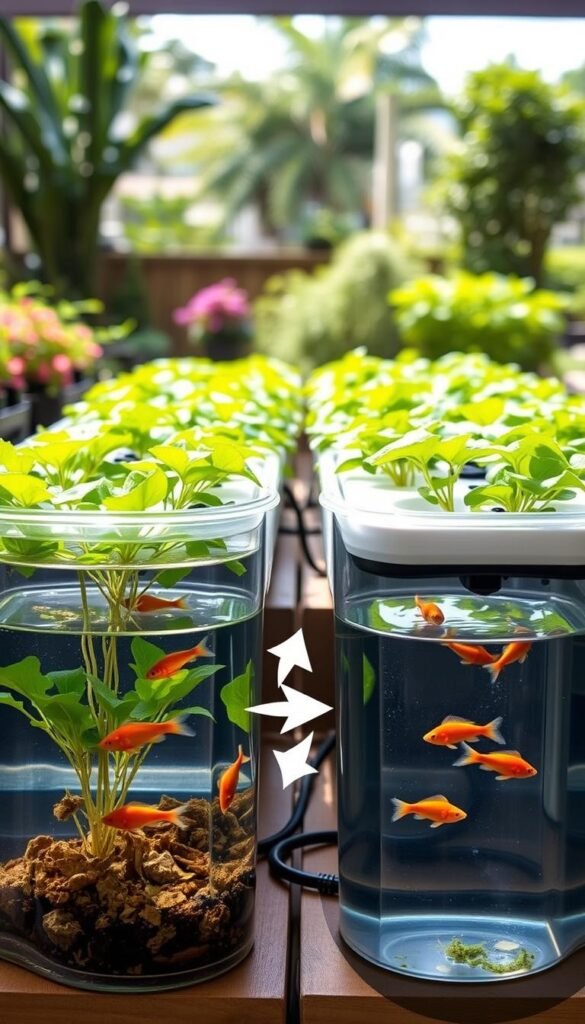
Choosing between these innovative growing methods? Let’s break down their strengths and weaknesses. Both systems deliver impressive yields, but their approaches to nutrient management and ecosystem design vary dramatically.
Hydroponics shines in speed and control. Leafy greens grow 30% faster with synthetic solutions tailored to exact needs. Commercial strawberry farms using drip systems report 40% higher yields than soil methods. But this precision comes at a cost—monthly nutrient purchases and strict pH monitoring.
Aquaponics offers sustainability. Tilapia tanks provide free fertilizer through natural waste conversion. You’ll use 90% less water than traditional farming while harvesting both fish and veggies. However, balancing fish health with plant needs adds complexity—power outages can crash the entire ecosystem within hours.
| Factor | Aquaponics | Hydroponics |
|---|---|---|
| Startup Cost | $500+ | $350+ |
| Monthly Inputs | Fish food | Synthetic nutrients |
| Maintenance Time | 45 mins/day | 25 mins/day |
Urban gardeners love hydroponics for compact system designs like vertical NFT towers. Those prioritizing organic practices lean toward aquaponics—no synthetic chemicals touch your kale or basil. Consider your space, budget, and patience for troubleshooting live ecosystems versus sterile solutions.
Ultimately, your goals decide. Want rapid harvests with less hassle? Hydroponics delivers. Prefer a closed-loop environment that mimics nature? Dive into aquaponics. Both methods beat soil gardening in efficiency—pick the one aligning with your lifestyle.
Environmental Impact and Sustainability Factors
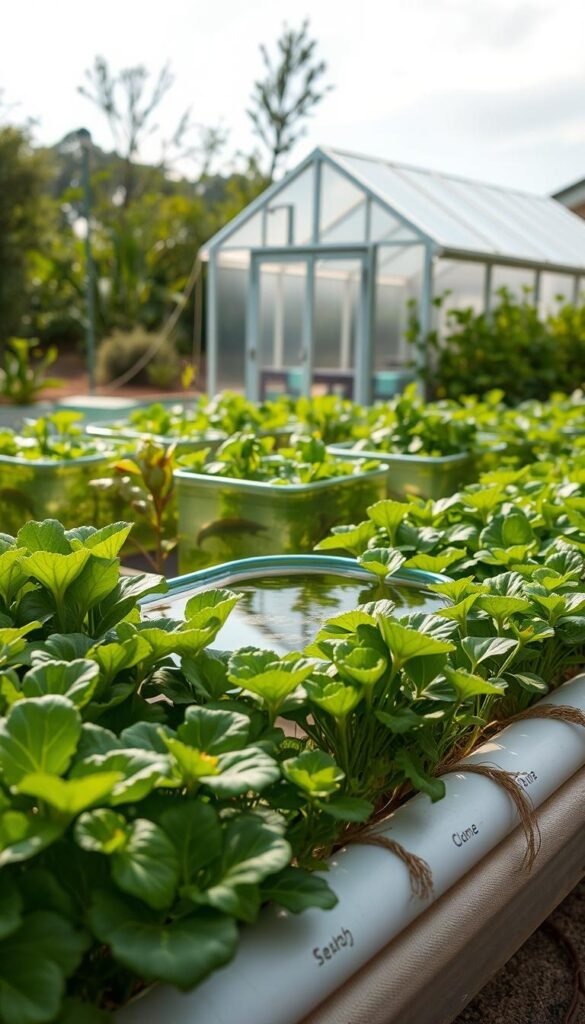
Your gardening choices ripple beyond your backyard. Both aquaponics and hydroponics slash resource use compared to soil farming—but their environmental footprints differ dramatically. Let’s explore how these systems affect ecosystems and long-term sustainability.
Reducing Chemical Inputs and Pesticide Use
Aquaponics eliminates synthetic fertilizers by turning fish waste into plant food. Beneficial bacteria handle nutrient conversion naturally, creating a chemical-free loop. Since pests struggle in water-based setups, pesticide use drops by 95% compared to soil gardens.
Hydroponics relies on lab-made nutrient solutions. While efficient, these formulas often contain non-organic salts. Runoff from hydroponic systems can introduce excess nitrogen into waterways, harming aquatic life.
Creating a Balanced Ecosystem
Aquaponics mimics nature’s circular design. Fish, plants, and microbes work together—water cycles endlessly, and waste becomes fuel. You’ll use 90% less water than traditional farming, with zero toxic runoff.
| Factor | Aquaponics | Hydroponics |
|---|---|---|
| Chemical Use | None | Monthly solutions |
| Water Recycled | 95-98% | 85-90% |
| Wildlife Impact | Positive (closed loop) | Neutral |
Want minimal environmental impact? Aquaponics’ self-cleaning design protects local waterways. For those prioritizing speed, hydroponic systems for beginners offer precision without fish care. Your choice shapes not just harvests, but the planet’s health too.
Choosing the Right System for Your Needs
Ready to pick your perfect growing setup? Your space, budget, and favorite crops will steer this decision. Let’s map out how to match your situation with the ideal method.
Space, Resources, and Desired Produce
Compact apartments thrive with hydroponic systems. Vertical NFT towers fit 20 plants in 4 square feet—perfect for herbs and lettuce. Got a garage or backyard? Aquaponics systems need room for fish tanks but reward you with tilapia and tomatoes.
Consider these factors:
| Factor | Aquaponics | Hydroponics |
|---|---|---|
| Space Needed | 50+ sq ft | 10-20 sq ft |
| Best Crops | Leafy greens, fish | Herbs, strawberries |
| Daily Care | Fish feeding, pH checks | Nutrient monitoring |
Love interacting with live ecosystems? Aquaponics lets you harvest food while nurturing fish. Prefer set-and-forget simplicity? Hydroponics needs just weekly solution changes.
Startup costs matter too. Hydroponic kits begin at $200, while aquaponic systems often exceed $500. But remember: fish become a self-sustaining nutrient source, cutting long-term expenses.
Still torn? Ask yourself:
- Do I want organic produce without chemicals?
- Can I commit 30 minutes daily to maintenance?
- Is producing both plants and fish appealing?
Your answers will spotlight the right method. Both options beat soil gardening—now choose your adventure!
Final Reflections on Aquaponics and Hydroponics
Deciding between these innovative growing methods? Both systems deliver impressive results while conserving resources. Aquaponics shines for those craving sustainability—it transforms fish waste into plant food through natural bacterial processes. You’ll harvest greens and protein while recycling 95% of water. But remember: balancing pH for fish and plants demands daily attention.
Hydroponics offers precision. Tailor nutrient mixes to accelerate growth rates by 30%, perfect for urban spaces or commercial growers. No fish care means simpler maintenance, though synthetic solutions require monthly purchases. Both methods outperform soil gardening in water efficiency—neither wastes precious drops.
Your priorities determine the best fit. Love hands-on ecosystems? Dive into aquaponics. Prefer predictable results? Hydroponics delivers. Either way, you’ll slash pesticide use and grow food faster than traditional methods.
Ready to start? Match your space, budget, and patience to these systems. Compact apartments thrive with vertical hydroponic towers, while backyard setups can host thriving aquaponic ecosystems. Let your goals guide you—both paths lead to fresher meals and greener living.

